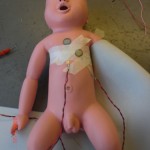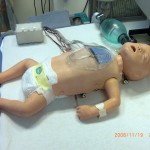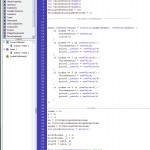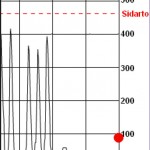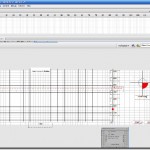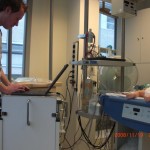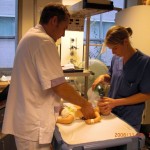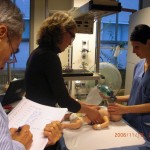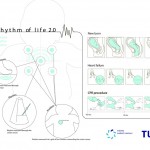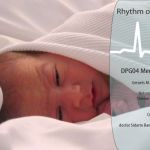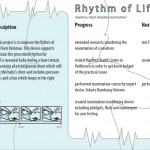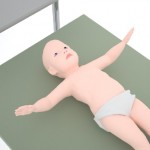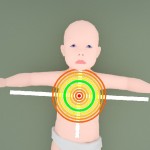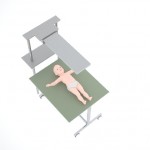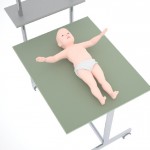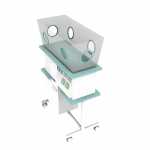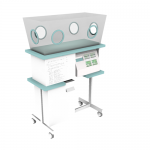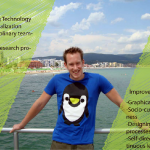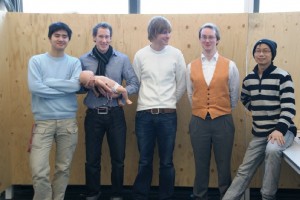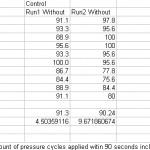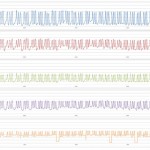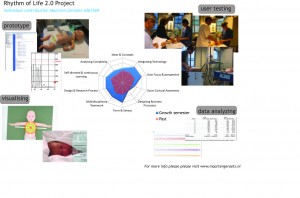Rhythm of Life 2.0 Project
Rhythm of life 2.0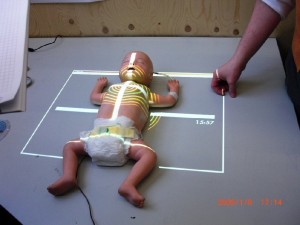
Client S. Bambang Oetomo – MMC Veldhoven
Coach Wei Chen
Theme Medical Care
Date 01-09-2008 09-01-2009
Project description:
The main focus of the project was the birth of a baby. Sometimes when a baby is born it might get a heart attack, which occurs frequently. The hospital staff is special trained to act within these situations, but besides a good training also proper tools are required for a quick and efficient response. The lack of a suitable instruments for such situations is the starting point of this project, ‘Rhythm of Life’. The goal of this project is to create a tool that supports the medical staff to increase the efficiency of the executed reanimation. And thus increases the chance of survival and decreasing the chance of complications, such as brain damage due to a lack of oxygen to the brain. We are going to design a device which supports the staff while performing reanimation (CPR). Master student Floris Kimman already made a (untested) concept during his Rhythm of Life project, which would be our starting point for this project.
Concept description:
The final design we made is integrated into the reanimation desk and will assist the staff while performing reanimation (CPR). Once the baby is placed on the desk the device will automatically produce a rhythmic sound corresponding to the right frequency of CPR. Furthermore on the chest of the baby a visualization is shown which indicated the right placement of the staff’s thumbs as well the amount of relative and prescribed pressure onto the babies chest. Furthermore vital information concerning the baby’s health is projected onto the table. This will support the staff to react faster as well maintaining the correct procedure while performing CPR.
Reflection:
Project
The ‘Rhythm of Life 2′-project was my first second years project. This enabled me to apply to goals I made in advance and to go deeper into certain design phases since in previous projects there was no opportunity to this due the short project-periods. During the project I was engaged in creating prototypes, performing professional user testing, visualizing, multidisciplinary teamwork and data analyzing.
Integrating Technology
Concerning the prototype I extended my knowledge of creating interactive prototypes using Flash and Phidgets.Within this project I applied the Flash/Phidgets knowledge I gathered from my Sparkling Home project. During the Rhythm of Life 2.0 project I extended this experience by using different sensors, like pressure sensors and I learned how to record data from the sensors. I also became more aware of different ways to use timers in Flash. From our user tests I learned that it is better to use the internal clock of the computer rather that making my own timer. Due to huge amount of data which the computer has to process it will lead to imprecise and unreliable results. Some pictures of the prototype are shown below:
User Focus & Perspective
During the project I was engaged in performing a real professional user test including at least 20 persons in the Maxima Medical Centre in Veldhoven. I had some minor user experience before due to small user tests during projects and the assignment User testing I did in B1.2R2. We tested our prototype on nurses and doctors of the neonatal department of the MMC. We split the couples up in two groups: the testing group and the control group. The couples of the testing group performed CPR with the device and the control group would perform CPR without using the device. In this way we did a quantitative as well qualitative user test; because we tested the device on a relative big amount of people (20+ people, 4 test runs per person) including a questionnaire for vital feedback afterwards.
This was my first user testing with a professional setup. I learned that good preparation in advance is very important. We performed a pilot test in advance in order to check everything. However we missed some small details, so next time when I will perform a user test I will address some more pilot tests in advance. We also took some spare parts with us towards the hospital in case when something broke down, which eventually happened. We also took the decision to videotape everything. Afterwards I’m very glad we did this, because something went wrong while collection data with the computer (see integrating technology part). Looking back at the video gave us more reliable results. I will take this in mind for the next user tests. Furthermore a good deviation of the tasks between the team members during the user test is important. This will result in a fluent course and increases the of the user test. Moreover I learned that it can be handy to do a small interview or questionnaire directly after the user test, while the information is still fresh in their minds. In this way I can get vital information about the users and the product. I can prepare some questions in advance in order to get the conversation started. But it is also important to take unexpected feedback in mind. Therefore it might be interesting to ask the user if he got any other feedback which was not discussed during the conversation. I’ll take this information in mind the next time I perform user testing.
Form & Senses
During the expositions we showed some posters and flyers towards the audience. One of my goals was to become more experienced in using Illustrator, a vector-based visualization application. I had a little bit of experience before, but during this project I engaged myself in making the leaflets and a poster for the expositions. I’m now more experienced with Illustrator. It enables me to create high quality poster, flyers or leaflets. However I should keep practicing using this application to become more experienced with it. You can view some examples over here:
Furthermore I applied the knowledge from the Rhinoceros assignment in order to made some 3D renderings of our concept. As you can see over here:
From this activity I learned how to work with different light exposure angles and how to use Maxwell. Maxwell can be added to Rhinoceros in order to create more realistic renders and has a more advanced material library. Overall seen I got more experience of creating realistic renders for presentation purposes.
Multi-disciplinary teamwork
As described in my previous SE, one my previous goals was to to a small team a team-analyse in advance of the project which includes at least 3 mastering skills and 3 skills to development as concluded out of a personal questionnaire. This made the specialties of the teammates clear and contributed to a smooth task deviation. I will defiantly use this method again in the upcoming team projects.
Furthermore I became aware that, just as in real life as industrial designer, I have to face and collaborate with people of different (cultural) backgrounds. During the project there was sometimes contrast between the team members concerning visions, experiences and attitudes. This made me aware that as designer I should be open for this kind of input. I learned that I can learn from people who have other ways of thinking and rejudge my own ways of thinking. I also became aware that my role within this project was important. Unless our team leader was leading well, he lost his hold on to the team members sometimes. Due to my optimistic and social personality I was able to assist him sometimes, which he very appreciated. Also my awareness of technology was very useful within this project, especially during the concept realisation phase. Furthermore we contacted several experts which were very enthusiastic about our concept. This gave me satisfaction as becoming an industrial designer.
Design and Research Processes
The main focus of this project was to do scientific research and perform a professional user test, which is comparable with the Design Against Fear Project. This resulted regrettably in relative short idea generation and selection phases, since a second year project is perfect to go deeper into the creative phases of the design process. Looking back it would have been better to perform the user test of Floris’ device earlier in the design cycle. In this way there was more time to perform a second user test in the Hospital in order to see whether our concept is better or not.
Data analyzing
The prototype we designed for user testing enabled us to collect vital data about the reanimation procedure. Cause of the huge amount of complex data it was impossible to perform calculations by ourself. I became aware that Mathlab is a powerful application to process and visualize data. However I learned how to process and visualize data in Microsoft Excel and how to do calculations with it. I calculated averages, standard-deviations and T-tests using Excel. Furthermore I visualized this data which made it useful to maintain overview of all the data. Also the use fixed values and standards (like pressure level and rhythm provided by the prescribed procedure) were useful to compare with the results of the user tests.
Growth as a designer:
Based on the story above I visualized my relative competency growth for this project. The main growth are the integrating technology (creating interactive prototypes), User Focus and Perspective (professional user test), Form & Senses (Illustrator & Rhinoceros) and analyzing complex data (outcome user test in Excel). Click on the picture to increase the size.
